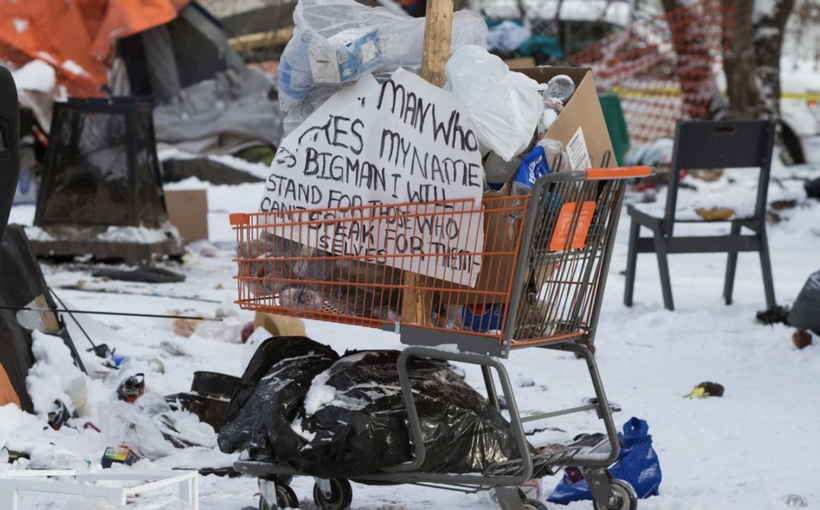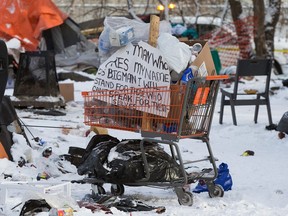This a real live mess featuring a bunch of interrelated conflicts that are all simultaneously playing out on the ground, in courtrooms and around political offices. In particular, the politics around this right now have become infuriating and immobilizing in which the battle for public perception seems to have been prioritized over public safety.
I’ll get to that in a moment. First, a little context is needed, which includes the recent controversial removals of eight “high-risk” encampments, protests, the arrest of an Indigenous journalist, the discovery of an arsenal of weapons at one location, and news that tents have again popped up at some of the sites that were previously cleared.
Meanwhile, the city has been suffering through some of winter’s harshest conditions, prompting a debate around whether it’s better to leave tents up to allow inhabitants at least some protection, or instead force them toward an emergency shelter that they may be unable or unwilling to use.
There is also a court hearing at play, which could, depending on a judge’s ruling next week, upend how encampments are managed. The plaintiffs in that case are arguing that teardowns should be severely restricted because they put people’s lives in danger. The city is arguing that the camps themselves are the danger, at least when they get to a certain state.
At city hall, a number of councillors are now claiming that the way encampment removals have been done of late aren’t exactly what they had in mind when they set the removal policy. In particular, they are questioning the timing — during such extreme weather — and the sufficiency of social infrastructure to assist displaced inhabitants.
To me, this argument comes across as at least a little disingenuous. Council is responsible for establishing that removal policy, and if they now feel there is a lack of clarity, or that it’s been misinterpreted by those implementing it, then much of the blame rests on their own shoulders.
Either way, there will surely be a great deal of tense discussion Monday during a special council meeting when Mayor Amarjeet Sohi intends to declare a housing and homelessness “emergency” in Edmonton.
Such a declaration has some truth to it — this has been a real crisis for a while — but as a tactic at this moment, it feels more performative than purposeful. What has really changed on the ground to now justify such a label?
Sohi’s main goal, it seems, is to compel a homelessness summit of all the major players. And while such a meeting seems appropriate, using the spectacle of an “emergency” declaration to make it happen seems sure to backfire with a thin-skinned provincial government.
That said, the province could have ignored the bait. Instead, Housing Minister Jason Nixon did exactly what he accused Sohi of doing — playing politics — by first characterizing the mayor’s position as a “stunt” and then getting personal by noting Sohi made the call while vacationing in Hawaii.
Nixon was attempting to suggest a certain insincerity on the mayor’s part, but instead his approach came across as hypocritical considering that the UCP government has had their heads in the sand on the homelessness crisis for most of the time they have been in office.
Yes, there has been an improvement from the province in recent months, including more funded shelter spaces and help for housing providers with operating costs. The government also formed a cabinet committee some weeks back on encampments, and has supposedly been working with city administrators and Indigenous officials.
That’s potentially good news, and yet there are indications this committee — not to mention the entirety of the provincial response — is still too narrowly constructed and exclusionary.
Essentially, the province seems to be telling the mayor and council, “Back off, we got this.” Except there is no compelling evidence to suggest they do.
For one thing, there seems to be some game-playing going on with reporting of available shelter beds. The province promised to have 1,700 spaces open in Edmonton by Nov. 1, but is still short of that. Just how far short is really unclear, lost in a fog of obfuscation and confusion over what constitutes a shelter facility, how full they are, whether a shelter is actually open or merely “funded,” and who actually has real numbers.
Shelter availability is likely to be pivotal in this week’s court decision, so you can understand the province’s focus on that. It is also the wrong focus if we ever hope to get out of this mess.
When it comes to shelters, the province needs to give much more attention to the question of why many homeless folks are avoiding such facilities and instead choose the risks of encampment life. Sure, shelters are not meant to be Hiltons, but ensuring sufficient quality, not just quantity, has to be a bigger part of the equation.
More importantly, the province at some point needs to concentrate less on shelters entirely and instead devote some of its massive surplus to longer-term interventions, particularly supportive housing.
Unfortunately, the government still appears stuck in a pattern of moral panic on that idea, and is instead intent on a doomed strategy that it can all be handled with a better economy, more law enforcement and forced admissions to recovery communities.
Perhaps some or all of those things should be part of the solution. But to truly address a problem of this scale and complexity, we need all parties and all ideas at the table, and an end to the political pettiness that keeps our most vulnerable on an endless merry-go-round of misery.




